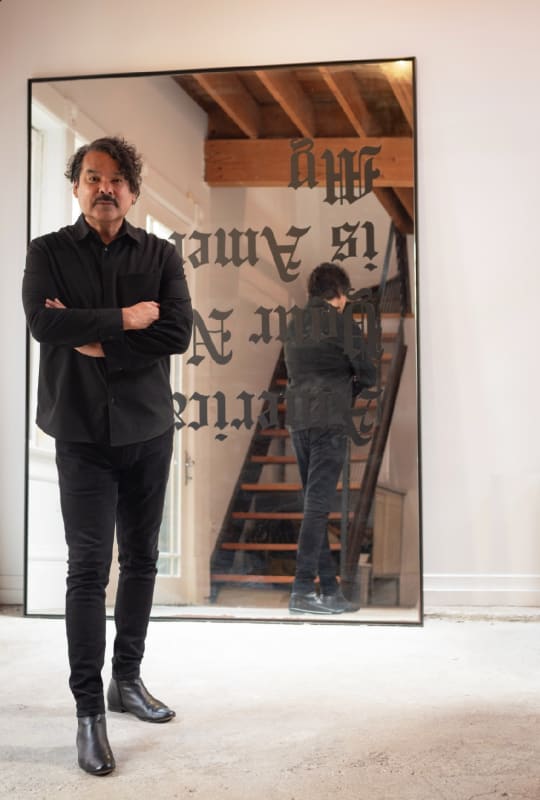Artist Julio César Morales grew up in Tijuana, moving with his family when he was 10 to San Diego, which was only a block away.
Today, in his large, light-filled Western Addition studio, a dub music mix is playing, and you can see how growing up on the border influenced his art. For example, some illustrations hanging on the walls are from a series begun in 2010, Undocumented Interventions, depicting dangerous attempts to cross the border without documentation. Morales started these after seeing an article about a 4-year-old girl who was hidden in a Powerpuff Girl piñata to cross into California.
Morales says this happened in the neighborhood where he grew up in Tijuana, La Zona Norte. “If you can't afford to get a safe passage, or even a coyote, people will go to these risks health-wise and mentally, to put their children in piñatas because it’ll only cost $150 to do that,” he says.
Pieces like these can be seen in his first survey, OJO, at the Jan Shrem and Maria Manetti Shrem Museum of Art at the University of California, Davis. They are among about 50 works in the show, including altered posters from The Border, a 1982 movie in which Jack Nicholson played a border patrol agent, and some work using pigment prints with plexiglass of a Dorothea Lange photo of migrants crossing the United States–Mexico border. The exhibition runs concurrently with Morales’ sixth solo exhibition at Gallery Wendi Norris, My America.
In January, Morales returned to San Francisco from Arizona, where he’s been working as a curator and museum director for about 12 years. He says both exhibitions, in the works for about a year and a half, mean a lot to him and feel like a homecoming.
Morales first moved to the City in the ’90s to get his BFA at the San Francisco Art Institute, studying with teachers such as Carlos Villa and Kathy Acker. After graduation, he went on to teach at SFAI as well as the California College of the Arts. He made art, wrote, worked at several arts institutions, founded the artist-run space Queens Nails Annex Gallery and started the now-defunct DJ collective and record label Club Unicornio in the Mission.
“I came to this conclusion very recently that I’m a musician,” Morales says. “But my instrument is visual art.”
Morales created a playlist for OJO that includes Nina Simone, Bad Bunny and Bomba Estéreo. For the gallery show, he made a sound installation, “My America Is Not Your America,” with Mexican Institute of Sound, an electronic music project. Thanks to a grant from the Svane Family Foundation, Morales put on a free public concert in Jackson Square on the opening night of the show last month.
Wendi Norris says she and Morales connected by talking about music after they met at another gallery showing his work. She loved his Undocumented Interventions series and how he used watercolor, a softer medium, for a gut-wrenching subject. In addition to the sound booth, the exhibition at her gallery includes new work from his Gemelos (Twins) series, depicting two people squeezing themselves into tight spaces to cross into the United States.
“These eight new watercolors that are coming in from the series Gemelos are incredibly well done,” Norris says. “From an execution perspective, he’s really able to take his time. He has a focused studio practice now, and that focus and dedication [are] apparent in the work that he’s bringing.”
Morales made the watercolors look like portals, a metaphor for a new future. “I’m trying to reflect on the value of immigrants, especially right now with ICE and what’s going on,” he says. “I want to give value and honor to the immigrant labor and their lives, not just from Latin America, but from around the world.”
Morales says the curators at Manetti Shrem treated him like they cared about him as a person. “They wanted to know about my experience growing up on the border, about moving to San Francisco, what it feels like to be a first-generation immigrant and include that story,” he says. “One thing we decided early on was: Why don’t we just tell a story?”
That’s what they wanted to do, says Evelyn Orantes, the interpretive specialist for OJO — by highlighting Morales’ experience and delving into how it connects with his artwork, including, for example, a five-minute video of him talking about how growing up between two cultures, two languages and two nations influenced him throughout his life.
“He said, ‘Most people who show my work don’t really connect to how living on the border was the big influence,’” Orantes says. “Being able to peel back the layers of Julio as a person, and how he is reflected in his artwork, has been a kind of a new angle, I think.”
Orantes also sees OJO as an exhibition all audiences can connect with. “All of us are looking for that moment where our families are happy and safe,” she says. “I think this show evokes some of the things that people are willing to do in pursuit of that happiness.”




